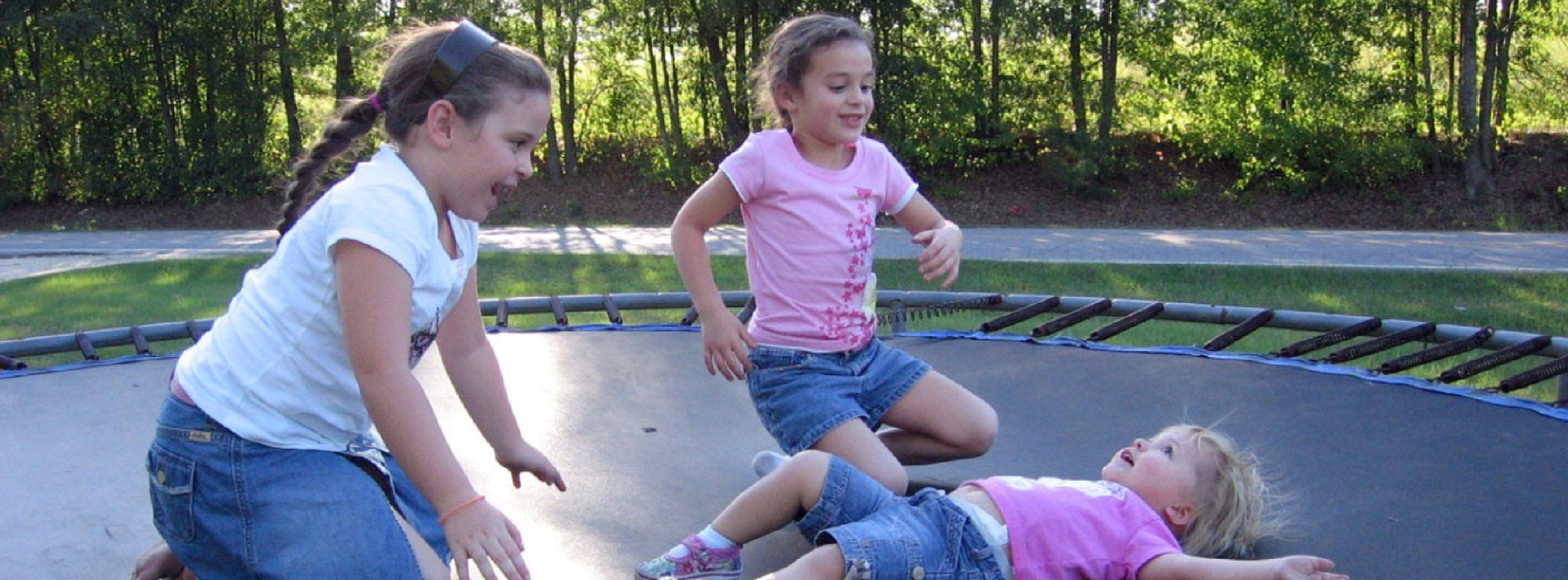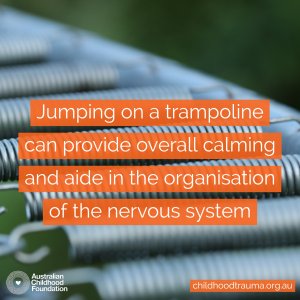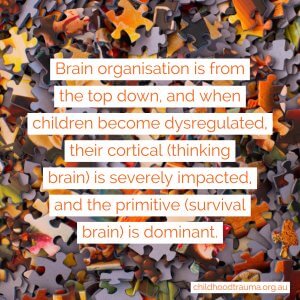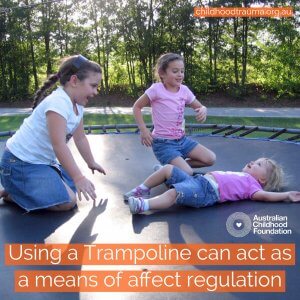
Jumping for your health – and to regulate
Research and therapeutic responses looking into how the body has been impacted by trauma have been of interest to many in the trauma field, and one form of intervention we have recently been using in therapeutic residential care settings has shown promising impacts… Jumping on the trampoline.
This blog entry was authored by Peter Burke, Therapeutic Specialist and
Jennifer Gay, Team Leader Therapeutic Care Program at the Australian Childhood Foundation
Experiences of abuse can cause significant disruptions to children’s development and can have ongoing impacts in many areas including memory, emotions, brain development, behaviour, learning and can have significant impacts on the body. Research and therapeutic responses looking into how the body has been impacted by trauma have been of interest to many in the trauma field, and one form of intervention we have recently been using in therapeutic residential care settings has shown promising impacts… Jumping on the trampoline.
 Jumping on a trampoline provides proprioceptive input (sense of body in space) and vestibular motion feedback (response to body’s movement travelling through space). Proprioceptive input is the performance of tasks that involve heavy resistance and input to the muscles and joints. Heavy work is any activity that pushes or pulls against the body. Jumping on a trampoline can, therefore, provide overall calming and aide in the organisation of the nervous system. It can improve attention, arousal level, body awareness and muscle tone, as well as decreasing defensiveness. It utilises the body weight of the person to provide the resistive input to the muscles and joints, providing a very grounding sensation to the nervous system. As children who have experienced Developmental Trauma have difficulties integrating their sensory experiences, jumping on the Trampoline can assist with this.
Jumping on a trampoline provides proprioceptive input (sense of body in space) and vestibular motion feedback (response to body’s movement travelling through space). Proprioceptive input is the performance of tasks that involve heavy resistance and input to the muscles and joints. Heavy work is any activity that pushes or pulls against the body. Jumping on a trampoline can, therefore, provide overall calming and aide in the organisation of the nervous system. It can improve attention, arousal level, body awareness and muscle tone, as well as decreasing defensiveness. It utilises the body weight of the person to provide the resistive input to the muscles and joints, providing a very grounding sensation to the nervous system. As children who have experienced Developmental Trauma have difficulties integrating their sensory experiences, jumping on the Trampoline can assist with this.
 In Therapeutic Residential Care houses, we care for children who have experienced Developmental Trauma. What we understand about children who have experienced Developmental Trauma is that they have extreme difficulty regulating their affective state, and find it difficult to be co-regulated with and by others. They have experienced disruptions in their social and emotional development, and their ability to form and maintain relationships has been impacted. Additionally, they frequently have experienced significant neurodevelopmental consequences of their disrupted care arrangements.
In Therapeutic Residential Care houses, we care for children who have experienced Developmental Trauma. What we understand about children who have experienced Developmental Trauma is that they have extreme difficulty regulating their affective state, and find it difficult to be co-regulated with and by others. They have experienced disruptions in their social and emotional development, and their ability to form and maintain relationships has been impacted. Additionally, they frequently have experienced significant neurodevelopmental consequences of their disrupted care arrangements.
We have also identified the significant therapeutic benefits of using Trampolines. Trampolines are useful therapeutic tools, and they can be used alone (supervised) or together with others (staggered shared use). This can promote cooperative dialogue between the young people. Using a Trampoline can act as a means of affect regulation. Developmental Trauma happens in the body when pre-conscious (implicit) memories are laid down in the primitive or (survival brain). The later development of the cortical (or thinking brain) allows it to modulate and mediate the activities of the survival brain.
Brain organisation is from the top down, and when children become dysregulated, their cortical (thinking brain) is severely impacted, and the primitive (survival brain) is dominant. In those circumstances, it is not possible to successfully engage the child through reason or language and strategies addressing the survival brain are used.
Bruce Perry (http://childtrauma.org/nmt-model/references/) discussed the importance of “patterned, repetitive, rhythmic somatosensory activities” as being effective to re-regulate the survival brain, to the point where the child is again accessible to reason and language. Providing these strong body movement experiences is an important step in the healing recovery process, and use of the Trampoline is very successful at achieving this. Additional strategies of discussion, distraction, and other activities can then be used.
Anecdotal experiences and the literature on neurodevelopment supports the efficacy of Trampolines as a very successful means of re-regulating children experiencing highly aroused states and can be instrumental in assisting them to re-establish an experience of greater calm. In one of the therapeutic residential houses that ACF works with it has been observed that the children use the trampoline in a number of ways. They regularly use the trampoline as a way of self-soothing – with the strong, deep pressure input of repetitive motion providing a calming sensation for their bodies, as a non-threatening form of socialiation and as a place where they can achieve some quiet time.
There are other health benefits of using a trampoline. According to the Bounce website (trampoline venue,)trampolining is said to be one of the best and most effective exercises you can do as it provides a “low-impact workout that tones muscles and improves co-ordination”. In fact, NASA has conducted research on the rebound exercise of jumping on trampolines that supports this. A study carried out by NASA found that 10 minutes bouncing on a trampoline is a better cardiovascular workout than 33 minutes of running. The report said, “for similar levels of heart rate and oxygen consumption, the magnitude of the bio-mechanical stimuli is greater with jumping on a trampoline than with running.”
 Bounce goes on to state that jumping on a trampoline can provide good health benefits such as ‘cardiovascular fitness, coordination and agility, muscle toning, low impact exercise, improving overall health by increasing your metabolic rate and strengthening bone condition’. Lastly, the website highlights the benefits of regular rebounding for stress relief by ‘increasing endorphins, providing relaxation, promoting better sleeping patterns and increasing the circulation of oxygen around your body, making you more alert and improving mental performance’.
Bounce goes on to state that jumping on a trampoline can provide good health benefits such as ‘cardiovascular fitness, coordination and agility, muscle toning, low impact exercise, improving overall health by increasing your metabolic rate and strengthening bone condition’. Lastly, the website highlights the benefits of regular rebounding for stress relief by ‘increasing endorphins, providing relaxation, promoting better sleeping patterns and increasing the circulation of oxygen around your body, making you more alert and improving mental performance’.
As well as the many identified health benefits outlined, trampolines have been a staple of many childhood memories. They have become more safety conscious over the years, and now you can access spring free models with safety nets. However, when you look deeper, they provide more than just a fun, healthy activity.
We continue to advocate for trampolines at the Therapeutic residential houses that we work with across ACF as they are then accessible for the young people and this also matches the community norm of the backyard trampoline of many children’s childhoods.
While there does not seem to have yet been any research done on this in the trauma field, it is hoped that funding can be secured for this worthwhile activity that can provide so many benefits to the young people that we care for.
